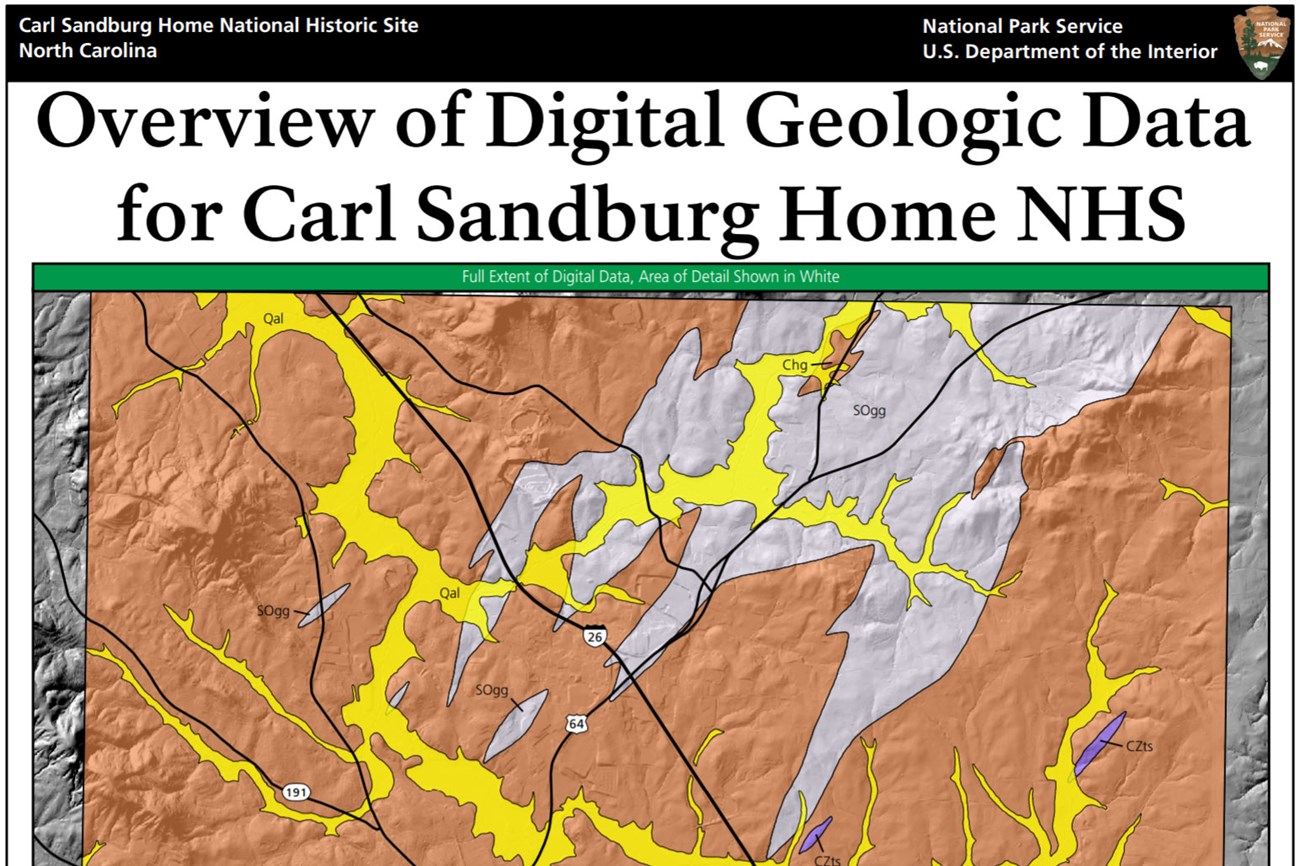Last updated: June 14, 2024
Article
NPS Geodiversity Atlas—Carl Sandburg Home National Historic Site, North Carolina
Geodiversity refers to the full variety of natural geologic (rocks, minerals, sediments, fossils, landforms, and physical processes) and soil resources and processes that occur in the park. A product of the Geologic Resources Inventory, the NPS Geodiversity Atlas delivers information in support of education, Geoconservation, and integrated management of living (biotic) and non-living (abiotic) components of the ecosystem.

Introduction
Carl Sandburg Home National Historic Site (CARL) is located in the southern Appalachian Mountains, about 64 km (40 mi) southeast of Great Smoky Mountains National Park and 32 km (20 mi) south of Asheville in Henderson County, North Carolina. Established on October 27, 1972, CARL contains approximately 106 hectares (264 acres) and commemorates the legacy of Carl Sandburg: the stories of his works, life, and importance as an American poet, writer, and social activist (National Park Service 2016a). Regarded as the “poet of the people”, Sandburg’s literary career captured and recorded America’s traditions, struggles, and dreams in his poetry, journalism, biographies, novels, and a collection of folk songs. The historic site preserves Connemara, the farm in Flat Rock, North Carolina, where Sandburg and his family lived for the last 22 years of his life (1945–1967). The Sandburgs’ personal belongings, furnishings, farm equipment, library, and papers are preserved at CARL and offer a unique perspective into the American author’s lifestyle, philosophy, and intellectual pursuits.
Geologic Setting
The bedrock of CARL consists entirely of Cambrian-age metamorphic rock of the Henderson Augen Gneiss. The Henderson Augen Gneiss was metamorphosed by heat and pressure generated during the numerous collisions that uplifted the Appalachian Mountains, and characteristically forms “domes” and other areas of high relief within CARL (Thornberry-Ehrlich 2012a). The vista observed from the trail to Glassy Mountain (named for light reflecting off the exposed bedrock) offers a panoramic view of nearby Mount Pisgah and the neighboring peaks of the Balsam Mountains. Bedrock outcrops within CARL inspired the previous owner Ellison Smyth to name the estate “Connemara” after the rugged landscape of quartzite and schist on Ireland’s western coast (Thornberry-Ehrlich 2012a).
Paleontological Resources
All NPS fossil resources are protected under the Paleontological Resources Preservation Act of 2009 (Public Law 111-11, Title VI, Subtitle D; 16 U.S.C. §§ 470aaa - 470aaa-11).
Abandoned Mineral Lands
NPS AML sites can be important cultural resources and habitat, but many pose risks to park visitors and wildlife, and degrade water quality, park landscapes, and physical and biological resources. Be safe near AML sites—Stay Out and Stay Alive!
Regional Geology
Carl Sandburg Home is a part of the Blue Ridge Physiographic Province and shares its geologic history and some characteristic geologic formations with a region that extends well beyond park boundaries.
- Scoping summaries are records of scoping meetings where NPS staff and local geologists determined the park’s geologic mapping plan and what content should be included in the report.
- Digital geologic maps include files for viewing in GIS software, a guide to using the data, and a document with ancillary map information. Newer products also include data viewable in Google Earth and online map services.
- Reports use the maps to discuss the park’s setting and significance, notable geologic features and processes, geologic resource management issues, and geologic history.
- Posters are a static view of the GIS data in PDF format. Newer posters include aerial imagery or shaded relief and other park information. They are also included with the reports.
- Projects list basic information about the program and all products available for a park.
Source: NPS DataStore Saved Search 2768. To search for additional information, visit the NPS DataStore.
A NPS Soil Resources Inventory project has been completed for Carl Sandburg Home National Historic Site and can be found on the NPS Data Store.
Source: NPS DataStore Saved Search 2750. To search for additional information, visit the NPS DataStore.

Related Links

